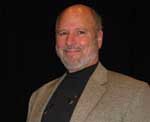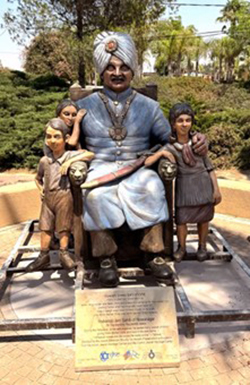By Jerry Klinger


NEVATIM, Israel — They called Jam Sahib, the “Good” Maharaja. Jam Sahib is much easier for me than trying to pronounce his Indian name, Jam Sahib Digvijaysinhji Ranjitsinhji Jadeja
He was Maharaja of Nawanagar from 1933 to 1966, North Western India. Jam Sahib personally saved over 1,000 Polish refugee children. He supported them. He sheltered them. He loved them. He opened his own house and funded them himself. He educated them in Polish language, culture, patriotism, and with the help of Polish priests, Catholicism.
He asked the children, many of whom were orphans, to call him Bapu – Father. He became their father and their protector.
Fifty years after his death, Poland’s Parliament honored him for his aid to Polish children and refugees during the Second World War. The “Good Maharaja’s Square” and a memorial with a street named after him were dedicated in Warsaw.
Poland sincerely appreciated the “Good Maharaja.” During the Nazi years, 6 million Poles died. Poland rarely points out that nearly 3 million of the victims were Jews. Of Poland’s 3.3 million pre-war Jewish population, ~ 375,000 survived. Poland has a long history of antisemitism. A very significant number of Poles energetically aided the Nazis in “cleansing” Poland of its Jews.
My mother’s family were Polish Jews. My aunt described to me the night the Nazis rounded her up and the last Jews of Piot-Rykov. It was a bitter winter night. The snow, the cutting icy sleet, bit into their skins. The Jews trudged down the main street late at night because the Nazis were not sure how the Poles would react at the sight of thousands of their Jewish neighbors being taken away.
She told me the Poles came out and lined the streets to watch the spectacle. They watched and jeered. She recalled to me their taunts, “We are finally getting rid of you. You are going to your deaths.” And most of the Jews did go to their deaths.
Not all Poles were monsters. Israel created a special tribute to those who, despite the Germans, despite their fellow antisemitic neighbors, tried to rescue Jews because they were their neighbors; because they were their fellow human beings. They risked their lives and sometimes paid for their efforts to save Jews with their lives.
The invasion of Poland by the Nazis began September 1, 1939. A massive refugee crisis ensued. Poles tried to escape to the East. Soon, 1/3 of all the refugees who made it to the Soviet Union were Jews. The Soviets did not want the Poles and certainly not the Jews. The refugees were brutally imprisoned and/ or sent to Siberia. In June 1941, the Nazis invaded Russia. The Soviets granted amnesty and released all its imprisoned Poles. Among the released were about 18,000 children. Their parents, if they were lucky enough to still have parents, faced a terrifying unknown. It was especially terrifying for the children of the Jewish parents. There was little doubt what the future would hold if the Nazis got them.
Polish humanitarian resources were galvanized to rescue the children. Caravans to the East and to India through Iran were organized. India had agreed to take in Polish refugees. But what to do with children? They were a unique problem.
Jam Sahib learned of the monstrous situation of the Polish children. He did not distinguish between Catholics and Jews. As a Hindu, he knew that human life was at risk. On his own, he directed over 1,000 children to Nawarangar, setting up a children’s camp at Balachadi on the coast. The number of children grew. He opened up his Palace and brought children to live with him. The children were saved. After the war, once it was deemed safe to return to Poland, the children were repatriated. Poland rightly, if belatedly, honored Jam Sahib.
What was never recognized was the fact that there were Jewish children among the Polish refugee children Jam Sahib saved. Historians have little to say on the subject. Without a doubt, many of the children who were old enough to understand were sternly warned to never, ever reveal they were Jewish as their parents kissed them a last goodbye. The priests, to their credit, never singled out the Jews. Nor did the priests come to Jam Sahib and ask for special help for the Jewish children. Jewish history and community in India is substantial. It is over 2,000 years old.
The Jewish children could not be repatriated to Poland after the war. Their parents were dead. Pogroms were occurring, and Poland did not want the Jews back. They had no place to go. Some went to Mandate Palestine, settling permanently in Israel and trying to rebuild their lives.
The story of Jam Sahib and the saving of Jewish children is known to the Israeli Indian Jewish Community. Ruth Greenfield, an Israeli Jew of Indian heritage whom I had worked with on a different project, shared the story with me. She thinks there were many more than a handful of Jewish children saved by Jam Sahib. She was in contact with Jews who had been some of the children that Jam Sahib saved.
Perhaps there were many more, perhaps not. What mattered was that Jam Sahib saved Jewish children. He deserved to be honored in Israel.
Poland has honored Jam Sahib for saving Poles. She asked me if I would help her honor Jam Sahib at the Indian Jewish Museum in Nevatim, southern Israel. I had both the resources and contacts to make it happen. We agreed upon a sculptural interpretation designed and created by noted Israeli artist Sam Philipe.
The sculpture has now been sited at the museum. It has not been dedicated. The Indian Jewish community is planning on a significant dedication in the near term. The Hamas/Hezbollah War has repeatedly delayed the event that means so much to them and to Israeli-Indian relations.
Researchers from Haifa University have been engaged in documenting the Jewish story of Jam Sahib, the man the children call Bapu.
The dedication stone of the Jam Sahib Memorial in Nevatim reads:
“During the Holocaust, at his own expense, he saved many Jewish children giving them shelter, care, and love in his own home
“-Whoever saves one life saves the world entire.” ~ Talmud
Erected 2024 by (the) Jewish American Society for Historic Preservation (and the) Indian Jewish Heritage Center, Cochin Jewish Heritage Center.”
*
Jerry Klinger is the President of the Jewish American Society for Historic Preservation